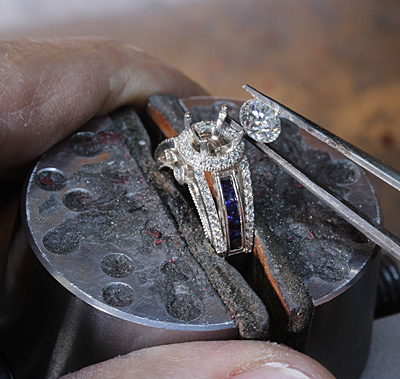Stone Setting
Setting stones is the process of attaching gemstones to a piece of jewelry. It seems simple enough; however, without the art of stone setting, the gemstones featured in jewelry would be at best under-utilized and at worst lost. Ironically, when stone setting is done properly it is not the intended focus of the jewelry.
The true goal of a stone setter is to set the stones in the most flattering and unobtrusive way possible. But in doing so, the setter must provide durability while the jewelry is being worn. We tend to take for granted that the gemstones in our jewelry do not just magically stay in place, when in fact, it takes an expert with experience and knowledge in the art of stone setting to do so artfully and properly.
Although jewelers setting stones in house is a rarity these days it is a service we offer. Our designer and master jeweler can replace lost stones or set existing stones. We are very comfortable with a variety of settings, such as, pave, channel, bezel, burnish, invisible, and many more.
Types of Stone Settings
While designing jewelry, our designer can choose from any number of stone setting methods. Each method is intended to give the gemstones and over all piece of jewelry a different look and feel. While some stone settings highlight a single stone and give it prominence. While other methods offer clusters of gems to be viewed as a whole. Here is a brief explanation of some of the settings we do in store at Albert Kaz Jewelry....
Prong Setting
Because of its use in engagement rings, prong settings are probably the most familiar to everyone. The most traditional kind of prong settings is either the four or six prong configuration. The prong setting allows light to enter from all sides of the gemstone, which increase the brilliance of the stone. It is by far the most popular method for setting individual featured gemstones.
Pave
The word pave comes from the French word for "paved". A pave setting is made up of lots of small gemstones, often, diamonds, set closely together. The gems are held in place with tiny beads of setting metal. The setting metal fades into the background and the result looks like a continuous surface of diamond or that the ring has been "paved" in diamonds.
Channel
A channel setting is a secure way to set smaller gemstones in a row flush with the band of a ring. The gemstones are placed in a "channel" formed by two stripes of precious metal. The clean appearance of channel settings make it well suited for a modern look of straight lines and simple elegance.
Bezel
A bezel setting uses a collar to wrap the entire rim of the gemstone in metal. This type of setting is the most secure and protects the gemstone the best, due to the fact, that the metal collar is slightly elevated around the gemstone. This distinctive setting is beloved for its sleek design and modern curves.
Burnish
Burnished gemstones are set flush with the band of the ring and completely surrounded by precious metal. It is, also, referred to as a flush setting. The burnish setting is often confused with a bezel setting; however, the difference is in how the setting is achieved. This particular setting is done by drilling holes in the band just large enough to hold the gemstones securely.
Invisible
This setting is almost self-explanatory; an invisible setting is a mounting that holds the gemstones in place without the setting itself being seen. Developed in France in the mid-1800s, this setting gives the appearance of floating gemstones in an almost mosaic fashion. This setting is one of most difficult and perhaps the most delicate.


